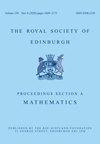S.P. Glasby, G.R. Paseman
求助PDF
{"title":"利用广义续分法使二项式系数的加权和最大化","authors":"S.P. Glasby, G.R. Paseman","doi":"10.1017/prm.2024.46","DOIUrl":null,"url":null,"abstract":"Let <jats:inline-formula> <jats:alternatives> <jats:tex-math>$m,\\,r\\in {\\mathbb {Z}}$</jats:tex-math> <jats:inline-graphic xmlns:xlink=\"http://www.w3.org/1999/xlink\" mime-subtype=\"png\" xlink:href=\"S0308210524000465_inline1.png\"/> </jats:alternatives> </jats:inline-formula> and <jats:inline-formula> <jats:alternatives> <jats:tex-math>$\\omega \\in {\\mathbb {R}}$</jats:tex-math> <jats:inline-graphic xmlns:xlink=\"http://www.w3.org/1999/xlink\" mime-subtype=\"png\" xlink:href=\"S0308210524000465_inline2.png\"/> </jats:alternatives> </jats:inline-formula> satisfy <jats:inline-formula> <jats:alternatives> <jats:tex-math>$0\\leqslant r\\leqslant m$</jats:tex-math> <jats:inline-graphic xmlns:xlink=\"http://www.w3.org/1999/xlink\" mime-subtype=\"png\" xlink:href=\"S0308210524000465_inline3.png\"/> </jats:alternatives> </jats:inline-formula> and <jats:inline-formula> <jats:alternatives> <jats:tex-math>$\\omega \\geqslant 1$</jats:tex-math> <jats:inline-graphic xmlns:xlink=\"http://www.w3.org/1999/xlink\" mime-subtype=\"png\" xlink:href=\"S0308210524000465_inline4.png\"/> </jats:alternatives> </jats:inline-formula>. Our main result is a generalized continued fraction for an expression involving the partial binomial sum <jats:inline-formula> <jats:alternatives> <jats:tex-math>$s_m(r) = \\sum _{i=0}^r\\binom{m}{i}$</jats:tex-math> <jats:inline-graphic xmlns:xlink=\"http://www.w3.org/1999/xlink\" mime-subtype=\"png\" xlink:href=\"S0308210524000465_inline5.png\"/> </jats:alternatives> </jats:inline-formula>. We apply this to create new upper and lower bounds for <jats:inline-formula> <jats:alternatives> <jats:tex-math>$s_m(r)$</jats:tex-math> <jats:inline-graphic xmlns:xlink=\"http://www.w3.org/1999/xlink\" mime-subtype=\"png\" xlink:href=\"S0308210524000465_inline6.png\"/> </jats:alternatives> </jats:inline-formula> and thus for <jats:inline-formula> <jats:alternatives> <jats:tex-math>$g_{\\omega,m}(r)=\\omega ^{-r}s_m(r)$</jats:tex-math> <jats:inline-graphic xmlns:xlink=\"http://www.w3.org/1999/xlink\" mime-subtype=\"png\" xlink:href=\"S0308210524000465_inline7.png\"/> </jats:alternatives> </jats:inline-formula>. We also bound an integer <jats:inline-formula> <jats:alternatives> <jats:tex-math>$r_0 \\in \\{0,\\,1,\\,\\ldots,\\,m\\}$</jats:tex-math> <jats:inline-graphic xmlns:xlink=\"http://www.w3.org/1999/xlink\" mime-subtype=\"png\" xlink:href=\"S0308210524000465_inline8.png\"/> </jats:alternatives> </jats:inline-formula> such that <jats:inline-formula> <jats:alternatives> <jats:tex-math>$g_{\\omega,m}(0)<\\cdots < g_{\\omega,m}(r_0-1)\\leqslant g_{\\omega,m}(r_0)$</jats:tex-math> <jats:inline-graphic xmlns:xlink=\"http://www.w3.org/1999/xlink\" mime-subtype=\"png\" xlink:href=\"S0308210524000465_inline9.png\"/> </jats:alternatives> </jats:inline-formula> and <jats:inline-formula> <jats:alternatives> <jats:tex-math>$g_{\\omega,m}(r_0)>\\cdots >g_{\\omega,m}(m)$</jats:tex-math> <jats:inline-graphic xmlns:xlink=\"http://www.w3.org/1999/xlink\" mime-subtype=\"png\" xlink:href=\"S0308210524000465_inline10.png\"/> </jats:alternatives> </jats:inline-formula>. For real <jats:inline-formula> <jats:alternatives> <jats:tex-math>$\\omega \\geqslant \\sqrt 3$</jats:tex-math> <jats:inline-graphic xmlns:xlink=\"http://www.w3.org/1999/xlink\" mime-subtype=\"png\" xlink:href=\"S0308210524000465_inline11.png\"/> </jats:alternatives> </jats:inline-formula> we prove that <jats:inline-formula> <jats:alternatives> <jats:tex-math>$r_0\\in \\{\\lfloor \\frac {m+2}{\\omega +1}\\rfloor,\\,\\lfloor \\frac {m+2}{\\omega +1}\\rfloor +1\\}$</jats:tex-math> <jats:inline-graphic xmlns:xlink=\"http://www.w3.org/1999/xlink\" mime-subtype=\"png\" xlink:href=\"S0308210524000465_inline12.png\"/> </jats:alternatives> </jats:inline-formula>, and also <jats:inline-formula> <jats:alternatives> <jats:tex-math>$r_0 =\\lfloor \\frac {m+2}{\\omega +1}\\rfloor$</jats:tex-math> <jats:inline-graphic xmlns:xlink=\"http://www.w3.org/1999/xlink\" mime-subtype=\"png\" xlink:href=\"S0308210524000465_inline13.png\"/> </jats:alternatives> </jats:inline-formula> for <jats:inline-formula> <jats:alternatives> <jats:tex-math>$\\omega \\in \\{3,\\,4,\\,\\ldots \\}$</jats:tex-math> <jats:inline-graphic xmlns:xlink=\"http://www.w3.org/1999/xlink\" mime-subtype=\"png\" xlink:href=\"S0308210524000465_inline14.png\"/> </jats:alternatives> </jats:inline-formula> or <jats:inline-formula> <jats:alternatives> <jats:tex-math>$\\omega =2$</jats:tex-math> <jats:inline-graphic xmlns:xlink=\"http://www.w3.org/1999/xlink\" mime-subtype=\"png\" xlink:href=\"S0308210524000465_inline15.png\"/> </jats:alternatives> </jats:inline-formula> and <jats:inline-formula> <jats:alternatives> <jats:tex-math>$3\\nmid m$</jats:tex-math> <jats:inline-graphic xmlns:xlink=\"http://www.w3.org/1999/xlink\" mime-subtype=\"png\" xlink:href=\"S0308210524000465_inline16.png\"/> </jats:alternatives> </jats:inline-formula>.","PeriodicalId":54560,"journal":{"name":"Proceedings of the Royal Society of Edinburgh Section A-Mathematics","volume":"3 1","pages":""},"PeriodicalIF":0.9000,"publicationDate":"2024-08-27","publicationTypes":"Journal Article","fieldsOfStudy":null,"isOpenAccess":false,"openAccessPdf":"","citationCount":"0","resultStr":"{\"title\":\"Maximizing weighted sums of binomial coefficients using generalized continued fractions\",\"authors\":\"S.P. Glasby, G.R. Paseman\",\"doi\":\"10.1017/prm.2024.46\",\"DOIUrl\":null,\"url\":null,\"abstract\":\"Let <jats:inline-formula> <jats:alternatives> <jats:tex-math>$m,\\\\,r\\\\in {\\\\mathbb {Z}}$</jats:tex-math> <jats:inline-graphic xmlns:xlink=\\\"http://www.w3.org/1999/xlink\\\" mime-subtype=\\\"png\\\" xlink:href=\\\"S0308210524000465_inline1.png\\\"/> </jats:alternatives> </jats:inline-formula> and <jats:inline-formula> <jats:alternatives> <jats:tex-math>$\\\\omega \\\\in {\\\\mathbb {R}}$</jats:tex-math> <jats:inline-graphic xmlns:xlink=\\\"http://www.w3.org/1999/xlink\\\" mime-subtype=\\\"png\\\" xlink:href=\\\"S0308210524000465_inline2.png\\\"/> </jats:alternatives> </jats:inline-formula> satisfy <jats:inline-formula> <jats:alternatives> <jats:tex-math>$0\\\\leqslant r\\\\leqslant m$</jats:tex-math> <jats:inline-graphic xmlns:xlink=\\\"http://www.w3.org/1999/xlink\\\" mime-subtype=\\\"png\\\" xlink:href=\\\"S0308210524000465_inline3.png\\\"/> </jats:alternatives> </jats:inline-formula> and <jats:inline-formula> <jats:alternatives> <jats:tex-math>$\\\\omega \\\\geqslant 1$</jats:tex-math> <jats:inline-graphic xmlns:xlink=\\\"http://www.w3.org/1999/xlink\\\" mime-subtype=\\\"png\\\" xlink:href=\\\"S0308210524000465_inline4.png\\\"/> </jats:alternatives> </jats:inline-formula>. Our main result is a generalized continued fraction for an expression involving the partial binomial sum <jats:inline-formula> <jats:alternatives> <jats:tex-math>$s_m(r) = \\\\sum _{i=0}^r\\\\binom{m}{i}$</jats:tex-math> <jats:inline-graphic xmlns:xlink=\\\"http://www.w3.org/1999/xlink\\\" mime-subtype=\\\"png\\\" xlink:href=\\\"S0308210524000465_inline5.png\\\"/> </jats:alternatives> </jats:inline-formula>. We apply this to create new upper and lower bounds for <jats:inline-formula> <jats:alternatives> <jats:tex-math>$s_m(r)$</jats:tex-math> <jats:inline-graphic xmlns:xlink=\\\"http://www.w3.org/1999/xlink\\\" mime-subtype=\\\"png\\\" xlink:href=\\\"S0308210524000465_inline6.png\\\"/> </jats:alternatives> </jats:inline-formula> and thus for <jats:inline-formula> <jats:alternatives> <jats:tex-math>$g_{\\\\omega,m}(r)=\\\\omega ^{-r}s_m(r)$</jats:tex-math> <jats:inline-graphic xmlns:xlink=\\\"http://www.w3.org/1999/xlink\\\" mime-subtype=\\\"png\\\" xlink:href=\\\"S0308210524000465_inline7.png\\\"/> </jats:alternatives> </jats:inline-formula>. We also bound an integer <jats:inline-formula> <jats:alternatives> <jats:tex-math>$r_0 \\\\in \\\\{0,\\\\,1,\\\\,\\\\ldots,\\\\,m\\\\}$</jats:tex-math> <jats:inline-graphic xmlns:xlink=\\\"http://www.w3.org/1999/xlink\\\" mime-subtype=\\\"png\\\" xlink:href=\\\"S0308210524000465_inline8.png\\\"/> </jats:alternatives> </jats:inline-formula> such that <jats:inline-formula> <jats:alternatives> <jats:tex-math>$g_{\\\\omega,m}(0)<\\\\cdots < g_{\\\\omega,m}(r_0-1)\\\\leqslant g_{\\\\omega,m}(r_0)$</jats:tex-math> <jats:inline-graphic xmlns:xlink=\\\"http://www.w3.org/1999/xlink\\\" mime-subtype=\\\"png\\\" xlink:href=\\\"S0308210524000465_inline9.png\\\"/> </jats:alternatives> </jats:inline-formula> and <jats:inline-formula> <jats:alternatives> <jats:tex-math>$g_{\\\\omega,m}(r_0)>\\\\cdots >g_{\\\\omega,m}(m)$</jats:tex-math> <jats:inline-graphic xmlns:xlink=\\\"http://www.w3.org/1999/xlink\\\" mime-subtype=\\\"png\\\" xlink:href=\\\"S0308210524000465_inline10.png\\\"/> </jats:alternatives> </jats:inline-formula>. For real <jats:inline-formula> <jats:alternatives> <jats:tex-math>$\\\\omega \\\\geqslant \\\\sqrt 3$</jats:tex-math> <jats:inline-graphic xmlns:xlink=\\\"http://www.w3.org/1999/xlink\\\" mime-subtype=\\\"png\\\" xlink:href=\\\"S0308210524000465_inline11.png\\\"/> </jats:alternatives> </jats:inline-formula> we prove that <jats:inline-formula> <jats:alternatives> <jats:tex-math>$r_0\\\\in \\\\{\\\\lfloor \\\\frac {m+2}{\\\\omega +1}\\\\rfloor,\\\\,\\\\lfloor \\\\frac {m+2}{\\\\omega +1}\\\\rfloor +1\\\\}$</jats:tex-math> <jats:inline-graphic xmlns:xlink=\\\"http://www.w3.org/1999/xlink\\\" mime-subtype=\\\"png\\\" xlink:href=\\\"S0308210524000465_inline12.png\\\"/> </jats:alternatives> </jats:inline-formula>, and also <jats:inline-formula> <jats:alternatives> <jats:tex-math>$r_0 =\\\\lfloor \\\\frac {m+2}{\\\\omega +1}\\\\rfloor$</jats:tex-math> <jats:inline-graphic xmlns:xlink=\\\"http://www.w3.org/1999/xlink\\\" mime-subtype=\\\"png\\\" xlink:href=\\\"S0308210524000465_inline13.png\\\"/> </jats:alternatives> </jats:inline-formula> for <jats:inline-formula> <jats:alternatives> <jats:tex-math>$\\\\omega \\\\in \\\\{3,\\\\,4,\\\\,\\\\ldots \\\\}$</jats:tex-math> <jats:inline-graphic xmlns:xlink=\\\"http://www.w3.org/1999/xlink\\\" mime-subtype=\\\"png\\\" xlink:href=\\\"S0308210524000465_inline14.png\\\"/> </jats:alternatives> </jats:inline-formula> or <jats:inline-formula> <jats:alternatives> <jats:tex-math>$\\\\omega =2$</jats:tex-math> <jats:inline-graphic xmlns:xlink=\\\"http://www.w3.org/1999/xlink\\\" mime-subtype=\\\"png\\\" xlink:href=\\\"S0308210524000465_inline15.png\\\"/> </jats:alternatives> </jats:inline-formula> and <jats:inline-formula> <jats:alternatives> <jats:tex-math>$3\\\\nmid m$</jats:tex-math> <jats:inline-graphic xmlns:xlink=\\\"http://www.w3.org/1999/xlink\\\" mime-subtype=\\\"png\\\" xlink:href=\\\"S0308210524000465_inline16.png\\\"/> </jats:alternatives> </jats:inline-formula>.\",\"PeriodicalId\":54560,\"journal\":{\"name\":\"Proceedings of the Royal Society of Edinburgh Section A-Mathematics\",\"volume\":\"3 1\",\"pages\":\"\"},\"PeriodicalIF\":0.9000,\"publicationDate\":\"2024-08-27\",\"publicationTypes\":\"Journal Article\",\"fieldsOfStudy\":null,\"isOpenAccess\":false,\"openAccessPdf\":\"\",\"citationCount\":\"0\",\"resultStr\":null,\"platform\":\"Semanticscholar\",\"paperid\":null,\"PeriodicalName\":\"Proceedings of the Royal Society of Edinburgh Section A-Mathematics\",\"FirstCategoryId\":\"100\",\"ListUrlMain\":\"https://doi.org/10.1017/prm.2024.46\",\"RegionNum\":3,\"RegionCategory\":\"数学\",\"ArticlePicture\":[],\"TitleCN\":null,\"AbstractTextCN\":null,\"PMCID\":null,\"EPubDate\":\"\",\"PubModel\":\"\",\"JCR\":\"Q1\",\"JCRName\":\"MATHEMATICS\",\"Score\":null,\"Total\":0}","platform":"Semanticscholar","paperid":null,"PeriodicalName":"Proceedings of the Royal Society of Edinburgh Section A-Mathematics","FirstCategoryId":"100","ListUrlMain":"https://doi.org/10.1017/prm.2024.46","RegionNum":3,"RegionCategory":"数学","ArticlePicture":[],"TitleCN":null,"AbstractTextCN":null,"PMCID":null,"EPubDate":"","PubModel":"","JCR":"Q1","JCRName":"MATHEMATICS","Score":null,"Total":0}
引用次数: 0
引用
批量引用
摘要
让 $m,\,r\in {\mathbb {Z}}$ 和 $\omega \in {\mathbb {R}}$ 满足 $0\leqslant r\leqslant m$ 和 $\omega \geqslant 1$ 。我们的主要结果是涉及部分二项式和 $s_m(r) = \sum _{i=0}^r\binom{m}{i}$ 的表达式的广义续分。我们以此为 $s_m(r)$ 创建新的上界和下界,从而为 $g_{\omega,m}(r)=\omega ^{-r}s_m(r)$ 创建新的上界和下界。我们还在({0,\,1,\,\ldots,\,m\}$中定义了一个整数 $r_0,使得 $g_{omega,m}(0)<\cdots <;和 $g_{omega,m}(r_0)>\cdots >g_{\omega,m}(m)$ 。对于实数 $\omega \geqslant \sqrt 3$,我们证明 $r_0\in \frac {m+2}{\omega +1}\rfloor,\,\lfloor \frac {m+2}{\omega +1}\rfloor +1\}$ 、而且 $r_0 =\lfloor \frac {m+2}{\omega +1}\rfloor$ for $\omega \in \{3,\,4,\,\ldots \}$ 或者 $\omega =2$ and $3\nmid m$ .
本文章由计算机程序翻译,如有差异,请以英文原文为准。
Maximizing weighted sums of binomial coefficients using generalized continued fractions
Let $m,\,r\in {\mathbb {Z}}$ and $\omega \in {\mathbb {R}}$ satisfy $0\leqslant r\leqslant m$ and $\omega \geqslant 1$ . Our main result is a generalized continued fraction for an expression involving the partial binomial sum $s_m(r) = \sum _{i=0}^r\binom{m}{i}$ . We apply this to create new upper and lower bounds for $s_m(r)$ and thus for $g_{\omega,m}(r)=\omega ^{-r}s_m(r)$ . We also bound an integer $r_0 \in \{0,\,1,\,\ldots,\,m\}$ such that $g_{\omega,m}(0)<\cdots < g_{\omega,m}(r_0-1)\leqslant g_{\omega,m}(r_0)$ and $g_{\omega,m}(r_0)>\cdots >g_{\omega,m}(m)$ . For real $\omega \geqslant \sqrt 3$ we prove that $r_0\in \{\lfloor \frac {m+2}{\omega +1}\rfloor,\,\lfloor \frac {m+2}{\omega +1}\rfloor +1\}$ , and also $r_0 =\lfloor \frac {m+2}{\omega +1}\rfloor$ for $\omega \in \{3,\,4,\,\ldots \}$ or $\omega =2$ and $3\nmid m$ .

 求助内容:
求助内容: 应助结果提醒方式:
应助结果提醒方式:


